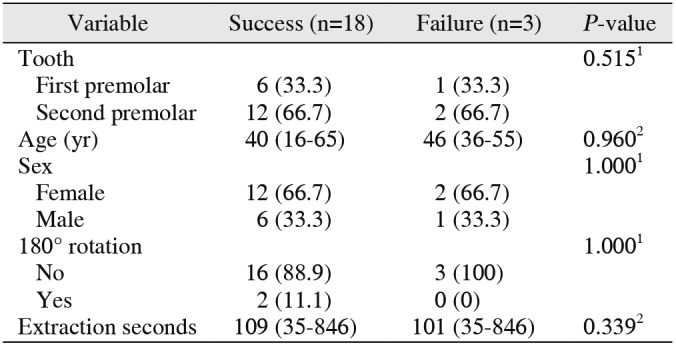1. Malhotra N, Kundabala M, Acharaya S. A review of root fractures: diagnosis, treatment and prognosis. Dent Update. 2011; 38:615–616. 619–620. 623–624 passim. PMID:
22238994.

2. Hayes M, Brady P, Burke FM, Allen PF. Failure rates of class V restorations in the management of root caries in adults - a systematic review. Gerodontology. 2016; 33:299–307. PMID:
25395000.

3. Juloski J, Radovic I, Goracci C, Vulicevic ZR, Ferrari M. Ferrule effect: a literature review. J Endod. 2012; 38:11–19. PMID:
22152612.

4. Olsburgh S, Jacoby T, Krejci I. Crown fractures in the permanent dentition: pulpal and restorative considerations. Dent Traumatol. 2002; 18:103–115. PMID:
12110103.

5. Rosenberg ES, Cho SC, Garber DA. Crown lengthening revisited. Compend Contin Educ Dent. 1999; 20:527–532. 534536–538 passim. quiz 542. PMID:
10650366.
6. Grossmann Y, Sadan A. The prosthodontic concept of crown-to-root ratio: a review of the literature. J Prosthet Dent. 2005; 93:559–562. PMID:
15942617.

7. Alsahhaf A, Att W. Orthodontic extrusion for pre-implant site enhancement: Principles and clinical guidelines. J Prosthodont Res. 2016; 60:145–155. PMID:
26979626.

8. Faria LP, Almeida MM, Amaral MF, Pellizzer EP, Okamoto R, Mendonça MR. Orthodontic extrusion as treatment option for crown-root fracture: literature review with systematic criteria. J Contemp Dent Pract. 2015; 16:758–762. PMID:
26522603.
9. Malmgren O, Malmgren B, Frykholm A. Rapid orthodontic extrusion of crown root and cervical root fractured teeth. Endod Dent Traumatol. 1991; 7:49–54. PMID:
1782893.

10. Elkhadem A, Mickan S, Richards D. Adverse events of surgical extrusion in treatment for crown-root and cervical root fractures: a systematic review of case series/reports. Dent Traumatol. 2014; 30:1–14. PMID:
23796195.

11. Yuan LT, Duan DM, Tan L, Wang XJ, Wu LA. Treatment for a complicated crown-root fracture with intentional replantation: a case report with a 3.5-year follow up. Dent Traumatol. 2013; 29:474–478. PMID:
22453056.

12. Tegsjõ U, Valerius-Olsson H, Olgart K. Intra-alveolar transplantation of teeth with cervical root fractures. Swed Dent J. 1978; 2:73–82. PMID:
279101.
13. Tegsjö U, Valerius-Olsson H, Frykholm A, Olgart K. Clinical evaluation of intra-alveolar transplantation of teeth with cervical root fractures. Swed Dent J. 1987; 11:235–250. PMID:
3481656.
14. Choi YH, Bae JH. Clinical evaluation of a new extraction method for intentional replantation. J Korean Acad Conserv Dent. 2011; 36:211–218.

15. Choi YH, Bae JH, Kim YK, Kim HY, Kim SK, Cho BH. Clinical outcome of intentional replantation with preoperative orthodontic extrusion: a retrospective study. Int Endod J. 2014; 47:1168–1176. PMID:
24527674.

16. Chen F, Qi S, Lu L, Xu Y. Effect of storage temperature on the viability of human periodontal ligament fibroblasts. Dent Traumatol. 2015; 31:24–28. PMID:
25236939.

17. Padbury A Jr, Eber R, Wang HL. Interactions between the gingiva and the margin of restorations. J Clin Periodontol. 2003; 30:379–385. PMID:
12716328.

18. Singh S, Thareja P. Fracture resistance of endodontically treated maxillary central incisors with varying ferrule heights and configurations: in vitro study. J Conserv Dent. 2014; 17:115–118. PMID:
24778504.

19. Eichelsbacher F, Denner W, Klaiber B, Schlagenhauf U. Periodontal status of teeth with crown-root fractures: results two years after adhesive fragment reattachment. J Clin Periodontol. 2009; 36:905–911. PMID:
19682174.

20. Gegauff AG. Effect of crown lengthening and ferrule placement on static load failure of cemented cast post-cores and crowns. J Prosthet Dent. 2000; 84:169–179. PMID:
10946334.

21. Meng QF, Chen LJ, Meng J, Chen YM, Smales RJ, Yip KH. Fracture resistance after simulated crown lengthening and forced tooth eruption of endodontically-treated teeth restored with a fiber post-and-core system. Am J Dent. 2009; 22:147–150. PMID:
19650594.
22. Chandler KB, Rongey WF. Forced eruption: review and case reports. Gen Dent. 2005; 53:274–277. PMID:
16158796.
23. Kim SH, Tramontina VA, Ramos CM, Prado AM, Passanezi E, Greghi SL. Experimental surgical and orthodontic extrusion of teeth in dogs. Int J Periodontics Restorative Dent. 2009; 29:435–443. PMID:
19639064.
24. Koc D, Dogan A, Bek B. Bite force and influential factors on bite force measurements: a literature review. Eur J Dent. 2010; 4:223–232. PMID:
20396457.

25. McGuire MK, Nunn ME. Prognosis versus actual outcome. III. The effectiveness of clinical parameters in accurately predicting tooth survival. J Periodontol. 1996; 67:666–674. PMID:
8832477.

26. Tsukiboshi M. Autotransplantation of teeth: requirements for predictable success. Dent Traumatol. 2002; 18:157–180. PMID:
12442825.

27. Torabinejad M, Anderson P, Bader J, Brown LJ, Chen LH, Goodacre CJ, et al. Outcomes of root canal treatment and restoration, implant-supported single crowns, fixed partial dentures, and extraction without replacement: a systematic review. J Prosthet Dent. 2007; 98:285–311. PMID:
17936128.

28. Torabinejad M, Dinsbach NA, Turman M, Handysides R, Bahjri K, White SN. Survival of intentionally replanted teeth and implant-supported single crowns: a systematic review. J Endod. 2015; 41:992–998. PMID:
25742795.

29. Da Silva JD, Kazimiroff J, Papas A, Curro FA, Thompson VP, Vena DA, et al. Practitioners Engaged in Applied Research and Learning (PEARL) Network Group. Outcomes of implants and restorations placed in general dental practices: a retrospective study by the Practitioners Engaged in Applied Research and Learning (PEARL) Network. J Am Dent Assoc. 2014; 145:704–713. PMID:
24982276.
30. Kim SG, Solomon C. Cost-effectiveness of endodontic molar retreatment compared with fixed partial dentures and single-tooth implant alternatives. J Endod. 2011; 37:321–325. PMID:
21329815.

31. Torabinejad M, Goodacre CJ. Endodontic or dental implant therapy: the factors affecting treatment planning. J Am Dent Assoc. 2006; 137:973–977. quiz 1027-8. PMID:
16803823.
32. Iqbal MK, Kim S. A review of factors influencing treatment planning decisions of single-tooth implants versus preserving natural teeth with nonsurgical endodontic therapy. J Endod. 2008; 34:519–529. PMID:
18436028.

33. Brozek JL, Akl EA, Jaeschke R, Lang DM, Bossuyt P, Glasziou P, et al. GRADE Working Group. Grading quality of evidence and strength of recommendations in clinical practice guidelines: part 2 of 3. The GRADE approach to grading quality of evidence about diagnostic tests and strategies. Allergy. 2009; 64:1109–1116. PMID:
19489757.






 PDF
PDF ePub
ePub Citation
Citation Print
Print



 XML Download
XML Download